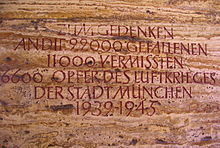War memorial in the Hofgarten (Munich)
The war memorial in the Hofgarten in Munich was in memory of the First World War built fallen Munich. It stands at the eastern, lower end of the Hofgarten , in front of the building of the Bavarian State Chancellery .
Building and sculpture
In a rectangular, 2.25-meter-deep pit, clad with shell limestone , there is an equally rectangular accessible crypt made of travertine blocks, in which lies the figure of the dead soldier.
Four narrow, angled stairs on the long sides lead into the pit, which measures 28 by 17 meters. On the walls of this anteroom to the crypt there are two reliefs showing marching soldiers and a burial ground. Twelve stone blocks support the 2-meter-thick and 250-tonne ceiling slab of the crypt. On its narrow sides, seven steps lead down to the larger than life figure of the dead soldier; the interior measures 7.30 by 3.50 meters.
The design of the memorial comes from a collaboration between the sculptor Karl Knappe and the architects Thomas Wechs and Eberhard Finsterwalder. Bernhard Bleeker created the dead soldier and the pedestal for it out of red marble ; In 1972 the original sculpture was replaced by a bronze cast by Thomas Wimmer; it is now in the Bavarian Army Museum in Ingolstadt.
The complex was inaugurated in 1924 in the presence of Crown Prince Rupprecht of Bavaria , the son of the last Bavarian king, but all details were not completed until 1928. It is a listed building.
Inscriptions
The phrase “ You will be resurrected ” is carved on the western side of the ceiling tile ; on the eastern side it says “ Our Fallen ”. In the interior you can read the inscription “ Erbaut / vom Obmannsiertel / München-Stadt / des Bayr. Kriegerbundes / den / 13,000 / fallen hero sons / the city of Munich / 1914-1918 ”, on the base of the soldier figure“ Bavaria's army / its dead ”. The side walls of the anteroom originally bore the names of the Munich fallen soldiers. After damage in the Second World War , the monument was restored in a simplified form, without the names. The names previously recorded can no longer be traced because the template for labeling (list of names) from the 1920s has also been lost. In the interior, after the Second World War, the additional dedication was made, “ In memory of the 22,000 fallen / 11,000 missing / 6,600 victims of the air war / the city of Munich / 1939-1945 ”.
reception
The war memorial in the Hofgarten, especially Bernhard Bleeker's impressive figure of the lying dead warrior, entered the Bavarian popular consciousness. The sculpture was modeled and varied several times for rural war memorials of the 1920s and 1930s, but also in the art representation, partly in connection with the corresponding Munich memorial inscription " You will be resurrected ". The war memorials in Neumarkt-Sankt Veit or the Palatinate communities of Höhmühlbach , Winterbach and Dietrichingen should be mentioned here . In the latter parish, the warrior figures were erected on steles of a gate with the Munich inscription in the middle.
War memorial in Höhmühlbach
War memorial in Winterbach
War memorial in Dietrichingen
literature
- August Alckens: The monuments and memorial stones of the city of Munich , Callwey, Munich 1936
- Lothar Altmann: The Bavarian State Chancellery , Schnell & Steiner, Regensburg 2001, ISBN 3-7954-6239-8
- Michaela Stoffels: War memorials as cultural objects. Concepts of mourning and nation in monuments of the Weimar Republic , Cologne 2011
Web links
- Bavarian State Office for Monument Preservation: War memorial, syn. War memorial
- stadt-muenchen.net: War memorial in the courtyard garden
Individual evidence
- ^ Benedikt Weyerer: Munich 1933–1949. City tours on political history . Buchendorfer, Munich 1996, ISBN 3-927984-40-X
- ↑ Illustrated website for the Neumarkt-Sankt Veit war memorial
Coordinates: 48 ° 8 ′ 33 " N , 11 ° 34 ′ 55" E







